
NEW YORK — In a nod to the 50th anniversary of the groundbreaking Woodstock music and art festival, which took place August 15-18, 1969, let’s take a look at psychedelic art, the most visually compelling product of the 1960s/early 1970s counterculture. Swirling patterns, distorted visuals, striking images and overly bright, often vibrating colors are the hallmarks of psychedelic art, which today’s collectors seek in various forms, including original concert posters, paintings, photography, murals, underground comic books and more.
“Psychedelic” comes from the Ancient Greek language and means “revealing” or “opening” the mind. Psychedelic art is synonymous with the hippie-trippy drug culture in the ’60s, when artists attempted to separate the art-making process from critical thinking and discover new ways to free their minds — whether through legal methods or otherwise.
“Let’s be realistic, the first thing that comes to mind when we think about psychedelic art is sixties and seventies rock music, and drugs of course,” says a commentary on the Widewalls website. However, it should be noted that artist experimentation with mind-altering substances was around long before psychedelic rock arrived on the scene.

The Bethel Woods Center for the Arts, the nonprofit cultural arts organization located at the historic site of the 1969 Woodstock festival in Bethel, New York, mounted a year-long celebration commemorating the 50th anniversary of Woodstock with a permanent main exhibit, “Woodstock and The Sixties,” and rotating special exhibits. Including a large collection of original Woodstock artifacts and art, its “We Are Golden” exhibition uses the 1969 Woodstock Music and Art Fair “as a metaphor for the tumult and human response of the entire decade of the ’60s in the hope that young people today may draw inspiration to articulate what it is that they want from their own world in their own time.”
Among contemporary artists noted for their contributions in the psychedelic art field are Peter Max (b. 1937-), Neil Kerman (b. 1948-) and Ryan McGinness (b. 1972-), as well as musicians like rock legend and Woodstock closing act Jimi Hendrix. An art dabbler, Hendrix enjoyed creating psychedelic watercolors and drawings.
Peter Max created stage banner art and posters for the 30th anniversary Woodstock concert in 1999 and is now in his sixth decade as a pop artist. His paintings are globally recognizable for their vivid colors and imagery. Houston-based Off The Wall Gallery unveiled a Peter Max retrospective exhibition in August 2019 to coincide with Woodstock’s 50th anniversary.

Gallery owner and longtime champion of the artist Mimi Sperber Wasserberg said cultural changes inspired Max’s artworks of the 1960s. “His work is greatly influenced by important causes such as world peace, rainforest preservation and animal rights,” she said. “As one of the most influential pop artists of our time, his work is iconic and remains as popular today as it was in the 1960s.”
“The hallmarks of a great psychedelic painting usually include bright, bold colors, energy and movement,” Wasserberg said. “Collectors should look for paintings with historical reference — vintage pieces that are more difficult to find as well as iconic imagery that represents the artist’s signature style.”
Color plays a central role in Neil Kerman’s artworks. “Color excites me, and I let my mood of the moment direct me to the color palette that most energizes me to paint,” the artist said in a statement.

Ryan McGinness, on the other hand, is inspired by the skateboard and surfing culture, and his work today includes paintings, sculptures and installations.
Music posters were a favorite “canvas” for psychedelic art and artist/poster designer Wes Wilson (b. 1937-), who is regarded as a premier designer of 1960 rock concert posters, including many created for Bill Graham’s Fillmore West concerts in San Francisco. According to Lobo Pop Art, Stanley George Miller, who was professionally known as “Mouse” and “Stanley Mouse,” is “notable for his 1960s psychedelic … cover art on Grateful Dead and Journey albums, as well as many others.”

Psychedelic art reflects a moment in time like no other genre and, for many, conjures memories of a time when the art was music and the music was art.
# # #


